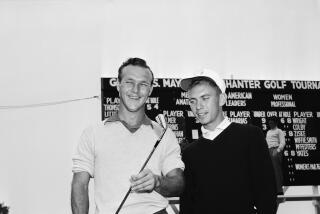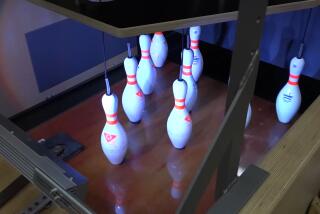Final jeopardy
ONE of my friends has gorilla arms and can launch a golf ball from the tee onto almost any green in just two strokes. Then he falls apart. The reason is simple: He doesn’t have a short game. He putts too hard, the dimpled little ball seems bewitched and, before you can say, “I think he’s gonna choke,” he’s triple-bogeyed. It’s not just his problem though: Most of us hackers have big trouble with our short game. Why is it that a three-foot putt can be more terrifying than teeing off over a pond or facing a sand trap the size of the Sahara?
Noah Liberman’s light, easy style in “The Flat Stick” describes the development of the putter and all the neuroses that afflict pros and weekend warriors alike as they confront their short game. This isn’t a “how-to” book but a pleasurable ramble through centuries of anecdotes surrounding that odd club with a vertical face that earned it the “flat stick” nickname.
Most clubs -- woods and irons alike -- have angled faces to give the golf ball different degrees of lift. But the putter was meant to keep the ball safely on the ground, hugging it all the way. In golf’s early days, though, a putter could hardly be distinguished from any other club in a player’s bag -- that’s because courses were scruffy, ragged landscapes maintained by scythe-swinging attendants and grazing animals. And a golf ball was little more than a tightly packed bunch of leather strips that “could not be depended on to roll precisely where you aimed it.”
If the United States Golf Assn. “really wanted to make the U.S. Open greens tough for the pros who love to complain about that tournament today,” Liberman quips, “it could just re-create the greens conditions of 1850 and listen for the screams.”
Around that time, things began to change -- that wobbly little leather mess was replaced by the rubber or “gutty” ball, and, in the decades that followed, lawnmowers became more commonly used at courses. Then, in the early 20th century, along came the path-breaking Schenectady, designed by a General Electric engineer in New York state. With its sleek mallet face and good weight distribution, the Schenectady has had a major influence on putters today.
Liberman catalogs all the designs -- including the Ping Anser, the Zebra, the Louisville Golf Stimp (it has adjustable weights) and the bestselling Odyssey White Hot 2-Ball (which has two golf-ball-size disks to help you line up your putt) -- that many a brain trust has devised in search of a better sweet spot. But before you shell out $300 for a Scotty Cameron putter or some new club designed by a NASA-type consortium, ponder what one golf exec told Liberman: “Putters are a little bit science, and a lot of smoke and mirrors.”
That’s because no matter how perfect a putter is, it’s still connected to a human being. If you’re out this summer on the links and the mojo suddenly gets bad, just remember that a champ like Colin Montgomerie gets “all a bit sweaty” over a four-foot putt and even the genteel Tiger Woods has been known to smash his club down in irritation.
Or take the photograph from “The Flat Stick’s” title page and make a T-shirt out of it to remind you that all golfers are mortal. The picture shows Woods, one hand clasping his forehead as if a migraine’s coming on, staring at the putt he just missed. As Liberman says, speaking for hackers everywhere, “Most of us golfers love our putters for a round or two. Then we hate them.” *
More to Read
Go beyond the scoreboard
Get the latest on L.A.'s teams in the daily Sports Report newsletter.
You may occasionally receive promotional content from the Los Angeles Times.










